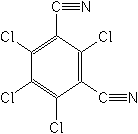Products >> Fungicides >> Chlorothalonil
Chlorothalonil
Chlorothalonil 72%SC
Chlorothalonil 75% WDG
Fungicide
FRAC Y; multi-site: chloronitrile

Chlorothalonil NOMENCLATURE
Common name chlorothalonil (BSI, E-ISO, (m) F-ISO, ANSI); TPN (JMAF)
IUPAC name tetrachloroisophthalonitrile
Chemical Abstracts name 2,4,5,6-tetrachloro-1,3-benzenedicarbonitrile
CAS RN [1897-45-6] EEC no. 217-588-1 Development codes DS-2787 (Diamond
Shamrock)
Chlorothalonil Chlorothalonil APPLICATIONS
Biochemistry Conjugation with, and depletion of, thiols (particularly
glutathione) from germinating fungal cells, leading to disruption
of glycolysis and energy production, fungistasis and fungicidal
action. Mode of action Non-systemic foliar fungicide with protective
action. Uses Control of many fungal diseases in a wide range of
crops, including pome fruit, stone fruit, citrus fruit, bush and
cane fruit, cranberries, strawberries, pawpaws, bananas, mangoes,
coconut palms, oil palms, rubber, pepper, vines, hops, vegetables,
cucurbits, tobacco, coffee, tea, rice, soya beans, peanuts, potatoes,
sugar beet, cotton, maize, ornamentals, mushrooms, and turf. Application
rates for food crops are 1-2.5 kg/ha. Phytotoxicity Russetting is
possible with flowering ornamentals, apples, and grapes. Some varieties
of flowering ornamentals may be injured. Pittosporum foliage is
sensitive. Phytotoxicity may be increased with oils or oil-containing
substances. Formulation types SC; WG; WP; Fogging concentrate. Compatibility
Not compatible with oils. Selected tradenames: 'Bravo' (Syngenta);
'Daconil' (Syngenta); 'Bombardier' (Unicrop); 'Clortocaffaro' (Caffaro);
'Clortosip' (Sipcam); 'Equus' (Griffin); 'Fungiless' (Sanonda);
'Gilonil' (Gilmore); 'Mycoguard' (Chiltern, Gharda); 'Repulse' (Hortichem);
'Teren' (Efthymiadis); 'Visclor' (Vischim); mixtures: 'Arbitre'
(+ tetraconazole) (Aventis)
Chlorothalonil OTHER TRADENAMES
'ISK 375' (Syngenta); 'Jupital' (Syngenta); 'Kvach' (Syngenta);
'Nopcocide' (Syngenta); 'Ole' (Syngenta); 'Tuffcide' (Syngenta);
'Atlas Cropgard' (Atlas Crop Protection); 'Barclay Corrib' (Barclay);
'Baton' (Bayer); 'Chloronil' (Vapco); 'Dragonil' (Agricultura Nacional);
'Echo' (Sipcam); 'Estampe' (France) (Bayer); 'Faber' (Tripart);
'Flute' (Sipcam UK); 'Mainstay' (Quadrangle); 'Miros' (Sipcam);
'Orchid' (GreenCrop); 'Passport' (SDS Biotech KK); 'Pilarich' (Pilarquim);
'Pugil' (Sipcam); 'Rover' (Sipcam); 'Rumble' (Probelte); 'Sipcam
UK Rover 500' (Sipcam); 'Strada' (Sipcam UK); 'Talone' (Chemiplant);
'Thayonil' (Agrochem); 'Tripart Faber' (Tripart); 'Tripart Ultrafaber'
(Tripart) mixtures: 'Bravo C/M' (+ copper oxychloride) (Syngenta);
'Bravocarb' (+ carbendazim) (Syngenta); 'Folio Gold' (+ metalaxyl-M)
(Syngenta); 'Folio' (+ metalaxyl) (Syngenta); 'Lynx' (+ hexaconazole)
(Syngenta); 'Octolan' (+ cyproconazole) (Syngenta); 'Reach' (+ triadimefon)
(Syngenta); 'Sirius' (+ hexaconazole) (Syngenta); 'Abitre' (+ tetraconazole)
(Aventis); 'Adagio' (+ mancozeb) (PBI); 'Allure' (+ prochloraz)
(Aventis); 'Alto Elite' (+ cyproconazole) (Syngenta, Bayer); 'Bravo
S' (+ sulfur) (Helena); 'Eminent Star' (+ tetraconazole) (Isagro);
'Halo' (+ flutriafol) (Syngenta, Cheminova); 'Impact Excel' (+ flutriafol)
(Syngenta, Cheminova); 'Merlin' (+ propamocarb hydrochloride) (Aventis);
'Music' (+ tetraconazole) (Sipcam Phyteurop); 'PP 375' (+ flutriafol)
(Syngenta, Cheminova); 'Prospa' (+ flutriafol) (Syngenta, Cheminova);
'Tattoo C' (+ propamocarb hydrochloride) (Aventis); 'Terranil S'
(+ sulfur) (Agro Distribution); 'Tripart Victor' (+ carbendazim+
maneb) (Tripart); 'Triumph' (+ flusilazole) (Du Pont); 'Vista CT'
(+ fluquinconazole) (Aventis); 'Voodoo' (+ tetraconazole) (Monsanto);
'Walabi' (+ pyrimethanil) (Aventis) Discontinued names: 'Exotherm
Termil' * (Zeneca) mixtures: 'Sambarin' * (+ propiconazole) (Novartis)
Chlorothalonil ANALYSIS
Product analysis by glc (D. L. Ballee et al., Anal. Methods Pestic.
Plant Growth Regul., 1976, 8, 263). Residues determined by glc (idem,
ibid.; A. Ambrus et al., J. Assoc. Off. Anal. Chem., 1981, 64, 733;
Man. Pestic. Residue Anal., 1987, I, 6, S19; Anal. Methods Residues
Pestic., 1988, Part I, M1, M12). In drinking water by gc with ECD
(AOAC Methods, 1995, 990.06). Details available from Syngenta.
Chlorothalonil MAMMALIAN TOXICOLOGY
Reviews CAG (see part 2 of Bibliography). IARC ref. 30; 73 class
2B Oral Acute oral LD50 for rats >5000 mg/kg. Skin and eye Acute
percutaneous LD50 for albino rabbits >10 000 mg/kg. Severe eye
irritant; mild skin irritant (rabbits). Evidence in humans of contact
dermatitis. Inhalation LC50 (1 h) for rats >4.7 mg/l air; (4
h) for rats (nominal concentration) 0.6 mg/l air; (4 h) for rats
(actual) 0.10 mg/l air. NOEL Chronic administration of chlorothalonil
has been associated with tumour formation in the kidney and forestomach
of rats and male mice. The mechanism has been demonstrated to be
epigenetic with a NOEL of 1.8 in rats and 1.6 in mice. In dogs,
the pattern of toxicity is different from that in rodents, with
a NOEL of at least 3 mg/kg b.w. (JMPR 1990). ADI (JMPR) 0.03 mg/kg
[1994]. Toxicity class WHO (a.i.) III (Table 5); EPA (formulation)
II ('Bravo' SC) EC hazard Xn; R40
ECOTOXICOLOGY
Birds Acute oral LD50 for mallard ducks >4640 mg/kg. Dietary
LC50 (8 d) for mallard ducks and bobwhite quail >10 000 mg/kg
diet. Fish LC50 (96 h) for rainbow trout 47, bluegill sunfish 60,
channel catfish 43 mg/l. Daphnia LC50 (48 h) 70 mg/l. Algae For
Selenastrum capricornutum, EC50 (120 h) 0.21 mg/l, NOEC (120 h)
0.1 mg/l. Other aquatic spp. LC50 (96 h) for pink shrimp 165 mg/l.
Bees No more than slightly toxic. Worms LC50 (14 d) >1000 mg/kg.
ENVIRONMENTAL FATE
EHC 183 (WHO, 1996) Animals Chlorothalonil is not well absorbed
following oral dosing. It reacts with glutathione in the gut lumen,
or immediately on absorption into the body, to give mono-, di- or
tri- glutathione conjugates. These may be excreted through urine
or faeces, or subject to further metabolism resulting in thiol or
mercapturic acid derivatives. Excretion of these in urine is believed
to be significantly greater in rats than in dogs or primates. In
ruminants, the 4-hydroxy metabolite may also be present, probably
as a result of its formation in the rumen. Plants In plants, the
majority of the residue remains as parent compound. The most abundant
metabolite, 4-hydroxy-2,5,6-trichloroisophthalonitrile, is generally
<10% of applied parent. Soil/Environment Koc 1600 (sand) to 14
000 (silt), indicating low mobility to immobile. In aerobic and
anaerobic soil studies, DT50 is 5-36 d. Degradation is faster in
biotic aquatic systems, typical DT50 (aerobic) <8 h, (anaerobic)
<10 d. A wide variety of metabolites is formed, which are in
turn degraded further.